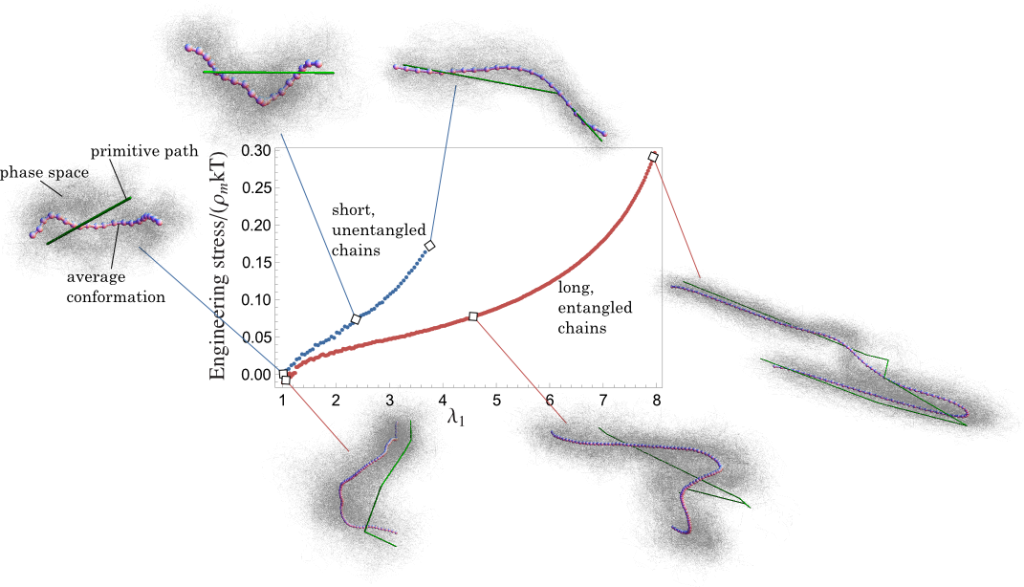Constitutive modeling of large deformation elasticity
 Engineering models of rubber elasticity require an accurate description of material stress-stretch behavior in order for effective use in design and simulation. A multiscale model based on the underlying physics and chemistry of an elastomer material was formulated in order to capture this mechanical behavior. Since the model has a simple form with physically based parameters, it can be used to represent different rubber materials undergoing large deformations and complex loading schemes; this model is also suitable for use in finite element simulations.
Engineering models of rubber elasticity require an accurate description of material stress-stretch behavior in order for effective use in design and simulation. A multiscale model based on the underlying physics and chemistry of an elastomer material was formulated in order to capture this mechanical behavior. Since the model has a simple form with physically based parameters, it can be used to represent different rubber materials undergoing large deformations and complex loading schemes; this model is also suitable for use in finite element simulations.
- Davidson, J. D. & Goulbourne, N. C. A nonaffine network model for elastomers undergoing finite deformations. Journal of the Mechanics and Physics of Solids 61, 1784–1797 (2013). Researchgate.
Molecular dynamics of elasticity and shape memory materials
Coarse-grained molecular dynamics (MD) simulations of material testing allow for the precise identification of how microscopic mechanisms contribute to relevant mechanical properties of elastomers. We used MD simulations to study the molecular basis of the shape memory effect and nonlinear elasticity in crosslinked polymers.
- Davidson, J. D. & Goulbourne, N. C. Microscopic mechanisms of the shape memory effect in crosslinked polymers. Smart Mater. Struct. 24, 055014 (2015). ResearchGate.
- Davidson, J. D. & Goulbourne, N. C. Nonaffine chain and primitive path deformation in crosslinked polymers. In review.
Mechanical testing of bat wing membranes

Soft biological tissues are distinguished by their relatively soft mechanical properties and heterogenous composition. Their elastic properties are due in large part to collgen and elastin components. Bats are unique in their flight characteristics, such as species which are able to stably hover near a food source by flapping their wings, and others which maintain flight with serious wing damage – even a hole in the membrane! We developed a biaxial testing apparatus for characterization of bat wing skin, which uses polarized light to measure the nonlinear stress and deformation of both the elastic fibers and skin matrix material.
- Skulborstad, A. J., Wang, Y., Davidson, J. D., Swartz, S. M. & Goulbourne, N. C. Polarized Image Correlation for Large Deformation Fiber Kinematics. Exp Mech (2013). doi:10.1007/s11340-013-9751-4. Researchgate.
Modeling electroactive polymer transducers
The focus of this research was to understand the electrochemical and mechanical mechanisms which lead to the operation characteristics of ionic liquid-ionic polymer transducers. These transducers are soft polymer actuators which can operate in air for long periods of time at low voltages (2-3 V) without performance degradation, as compared to their water-based couterparts (like in the video below) which must always be hydrated.
IPMC example: IPMC fish at Virginia Tech:
We contructed a mathematical model using a modified form of Nerst-Planck/Poission theory which predicts the electrochemical characteristics for ionic liquids which have different sizes and dissociation energies (which affects the amount of “free” ionic liquid ions in the polymer. The model predicts that transducers with the best actuation response can be made by using ionic liquids with a small fraction of “free” ions.
- Davidson, J. D. & Goulbourne, N. C. The influence of microstructure on boundary layer interactions in ionic polymer transducers. International Journal of Applied Mechanics 03, 365 (2011). Researchgate.
- Davidson, J. D. & Goulbourne, N. C. Nonlinear capacitance and electrochemical response of ionic liquid-ionic polymers. Journal of Applied Physics 109, 084901 (2011). Researchgate.
- Davidson, J. D. & Goulbourne, N. C. Boundary layer charge dynamics in ionic liquid-ionic polymer transducers. Journal of Applied Physics 109, 014909 (2011). Researchgate.

